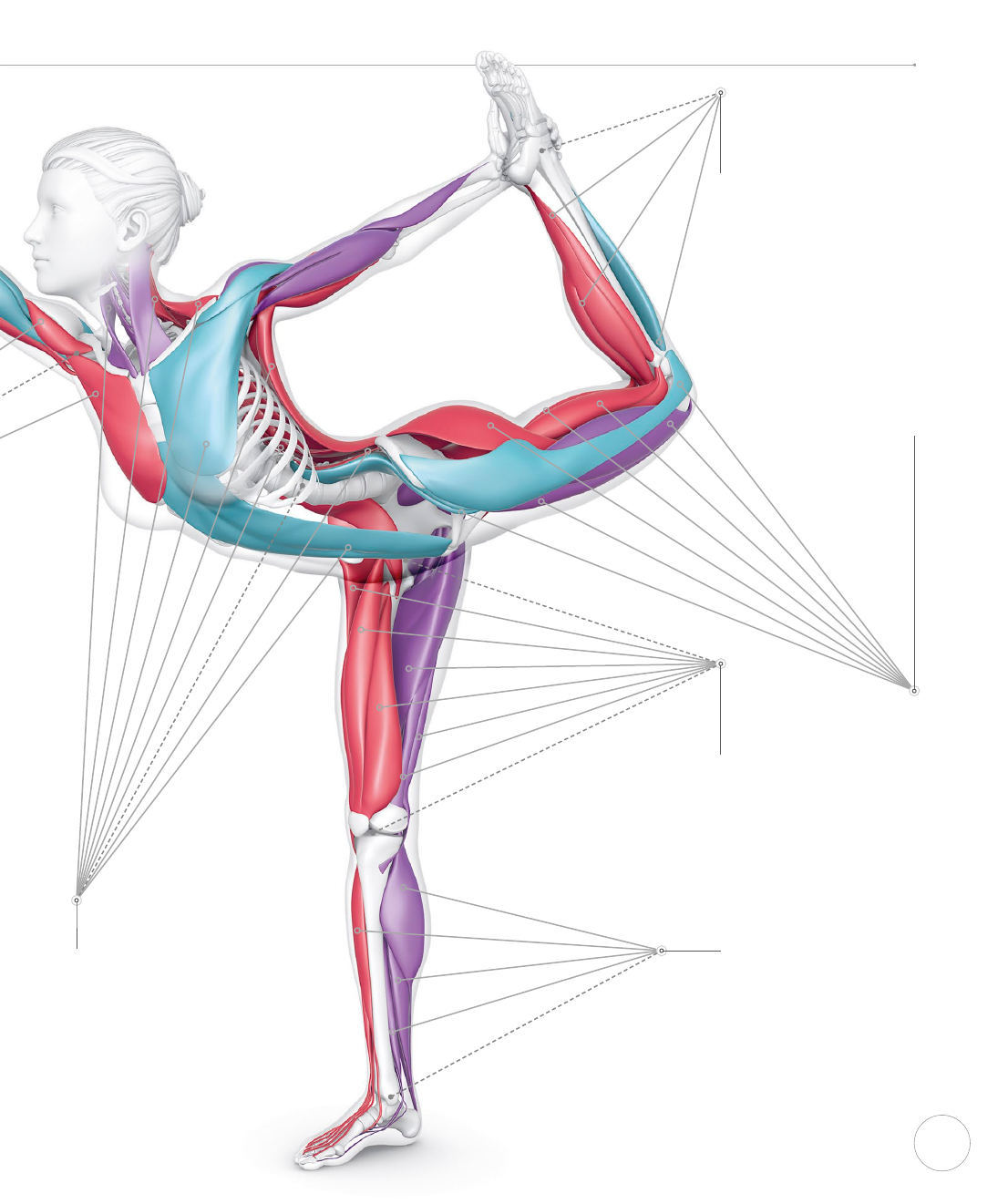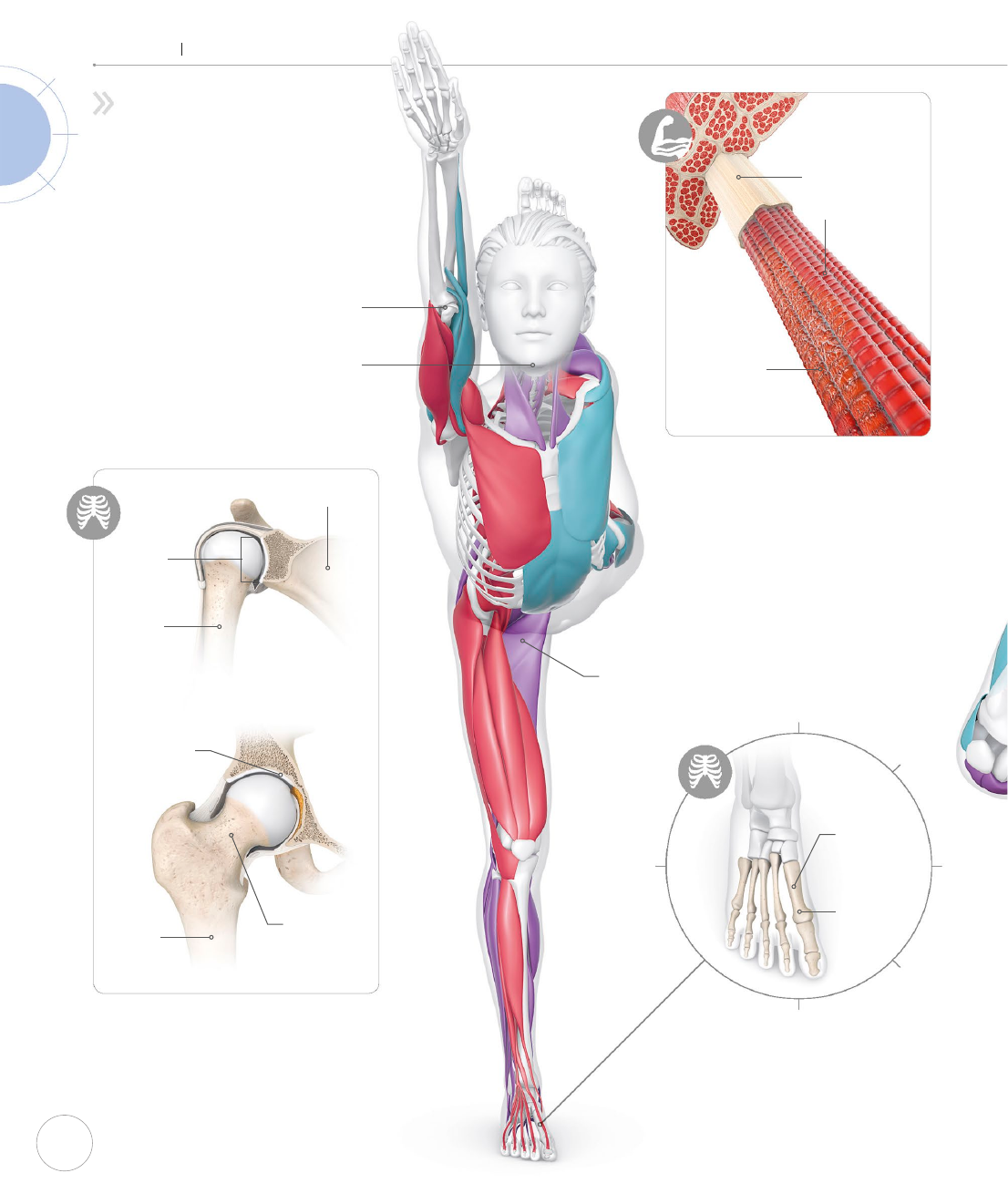
114
THE ASANAS
Standing
Dancer pose is a challenging static balancing pose,
which also develops strength, exibility, and agility.
Dynamic balance skills are required to transition in
and out of the pose with grace, though you can always
hold onto a wall or chair for steadiness.
THE BIG PICTURE
Large muscles of your standing hip,
thigh, and leg dramatically engage to
help you balance on one leg. The front
of your lifted hip and thigh stretch, as
you kick back as a counterbalance. Your
back muscles engage to come into a
backbend, while your chest and abdomen
stretch. Your neck is extended out long,
and your shoulders are relaxed.
DANCER
Natarajasana
Arms
In your front arm, your
anterior deltoid, pectoralis
major, and coracobrachialis
ex your shoulder, while your
triceps extend your elbow. In
your back arm, your posterior
deltoid, latissimus dorsi, and
teres major engage to extend
your shoulder, while your triceps
extend your elbow. Your elbow
exors also engage in a stretched
position to isometrically pull
your leg inward.
VARIATION
For a challenge, reach both arms up
and back to grasp your big toe. If you
feel pinching in your lower back, don’t
go as deeply into the bend. Also try
using a strap looped around your ankle.
Arms reach up
and back
Both hands
hold foot
ALIGNMENT
Your body weight is supported
by your standing thigh and lower
leg. For balance, kick your lifted leg
back into your hand as you pull it in
with equal and opposite force.
Gaze
forward
Breastbone
reaches up
and out
Relatively even
curve in spine
Hip points
facing down
Knee soft,
not locked
Press foot
into hand
KEY
Joints
Muscles
Engaging
Engaging while
stretching
Stretching
Deltoids
Triceps brachii
Biceps brachii
Brachioradialis
Shoulder
Elbow
Pectoralis major
US_114-115_Dancer_01.indd 114 20/09/2018 21:10

115
Standing lower leg
Your ankle is stabilized
by your tibialis anterior—
along with your calf
muscles—to resist wobbling.
Press your big toe down for
balance, and feel your exor
hallucis longus engage.
Lifted thigh
Your hip extensors engage
while your hip exors
stretch. Your hamstrings
engage to ex your knee.
Your quadriceps engage
while in a lengthened
position as you kick your leg
back into your hand.
Lifted lower leg
Your gastrocnemius and
soleus engage to plantarex
your ankle, while your tibialis
anterior stretches.
Standing thigh
Your hip exors—including the
iliopsoas, tensor fasciae
latae, and rectus femoris—
strongly engage, while your
hip extensors—including
your gluteus maximus and
hamstrings—stabilize you
into balance while in a
lengthened position.
Neck and torso
Your cervical extensors engage
to extend your neck while your
cervical exors stabilize, preventing
throwing your head back. Your spinal
extensors engage to extend your
spine while your abdominals stretch.
Your pectoralis major stretches,
particularly on your back arm. Your
middle and lower trapezius retract
and stabilize your scapulae.
Pectoralis major
Splenius muscles
Trapezius
Sternocleidomastoid
Latissimus dorsi
Spinal extensors
Spine
Rectus abdominis
Quadratus lumborum
Gastrocnemius
Tibialis anterior
Soleus
Ankle
Gluteus maximus
Semitendinosus
Iliopsoas
Rectus femoris
Vastus lateralis
Biceps femoris
Iliotibial band
Semitendinosus
Vastus medialis
Knee
Semimembranosus
Adductor magnus
Rectus femoris
Tensor fasciae latae
Hip
Gastrocnemius
Tibialis anterior
Soleus
Flexor hallucis longus
Ankle
US_114-115_Dancer_01.indd 115 20/09/2018 21:10

116
DANCER
Natarajasana
CLOSER LOOK
Dancer strikes a balance between
stability and mobility, along with
eort and ease. Muscles build in
strengthening poses like this
when microtears heal.
Your big
toe is key
for balance
First
metatarsal
Microtears on
muscle tissue
after exercise
Muscle fibers
Fiber bundle
How muscles build
Throughout your life, you can’t grow more
skeletal muscle cells. Instead, the cells can
grow larger in diameter. After exercising, your
muscle cells are left damaged—covered in
microtears—as a response to the benecial
stress on your tissue. Your body sends
nutrients to the area, helping it heal and
become even stronger than before.
Toe joints
In poses like Dancer, spreading your toes
helps you to balance. It can also counteract
hallux valgus (bunions) in which the big toe
joint turns inward, leading to bone deformity
and inammation around the joint.
Ball and socket joints
Both your shoulder and hip joints are ball and
socket joints (see pp.16–17). Your shoulder joint
is shallow with a lot of mobility; it is only limited
by ligaments and muscles. Your hip joint, in
contrast, is deeper with more joint structures
to help hold it securely in place.
Neck muscles stabilize
chin, lifting slightly
SHOULDER
HIP
Acetabulum is
deep, securing
head of femur
Femur
Humerus
Neck of
femur
Scapula
Glenoid
cavity
Elbow soft,
not locked
Adductors engage
and lengthen
ANTERIOR
VIEW
US_116-117_Dancer_02.indd 116 20/09/2018 21:10

117
THE ASANAS
Standing
Biceps brachii are in
a lengthened position
as you reach
Spinal extensors
engage to come
into a backbend
Posterior deltoid
engages to extend
your shoulder
Head feels light as
it lifts up and
slightly back
Muscle cramps
Cramping can occur due to neuromuscular fatigue, electrolyte
imbalance, and dehydration. If you have a cramp, try gently massaging
the muscle in a stretched position until it releases. Or, mindfully
engage the muscle while it’s in a stretched position, such as slowly
standing to bear weight for a calf cramp. Also, drink some water.
Gluteus maximus
engages to extend
your hip
Tensor fasciae latae
stabilizes your hip
and knee joints
Toes spread and
relax down
If you can’t
reach your foot,
use a strap
Engaged
calf muscle
Slightly
stretched
calf muscle
Cramping
calf muscle
Reach softly
through your
fingers
POSTERIOR–LATERAL VIEW
US_116-117_Dancer_02.indd 117 20/09/2018 21:10
..................Content has been hidden....................
You can't read the all page of ebook, please click here login for view all page.
